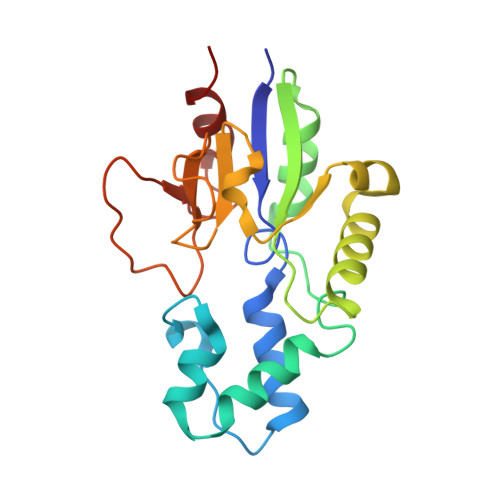Crystal structures of the mitochondrial deoxyribonucleotidase in complex with two specific inhibitors
Rinaldo-Matthis, A., Rampazzo, C., Balzarini, J., Reichard, P., Bianchi, V., Nordlund, P.(2004) Mol Pharmacol 65: 860-867
- PubMed: 15044615
- DOI: https://doi.org/10.1124/mol.65.4.860
- Primary Citation of Related Structures:
1Q91, 1Q92 - PubMed Abstract:
Monophosphate nucleotidases are enzymes that dephosphorylate nucleotides to their corresponding nucleosides. They play potentially important roles in controlling the activation of nucleotide-based drugs targeted against viral infections or cancer cells. The human mitochondrial deoxyribonucleotidase (dNT-2) dephosphorylates thymidine and deoxyuridine monophosphates. We describe the high resolution structures of the dNT-2 enzyme in complex with two potent nucleoside phosphonate inhibitors, (S)-1-[2'-deoxy-3',5'-O-(1-phosphono) benzylidene-beta-d-threo-pentofuranosyl]thymine (DPB-T) at 1.6-A resolution and (+/-)-1-trans-(2-phosphonomethoxycyclopentyl)uracil (PMcP-U) at 1.4-A resolution. The mixed competitive inhibitor DPB-T and the competitive inhibitor PMcP-U both bind in the active site of dNT-2 but in distinctly different binding modes, explaining their different kinetics of inhibition. The pyrimidine part of the inhibitors binds with very similar hydrogen bond interactions to the protein but with their phosphonate moieties in different binding sites compared with each other and to the previously determined position of phosphate bound to dNT-2. Together, these phosphate/phosphonate binding sites describe what might constitute a functionally relevant phosphate entrance tunnel to the active site. The structures of the inhibitors in complex with dNT-2, being the first such complexes of any nucleotidase, might provide important information for the design of more specific inhibitors to control the activation of nucleotide-based drugs.
Organizational Affiliation:
Department of Biochemistry and Biophysics, Stockholm University, Stockholm, Sweden.

















